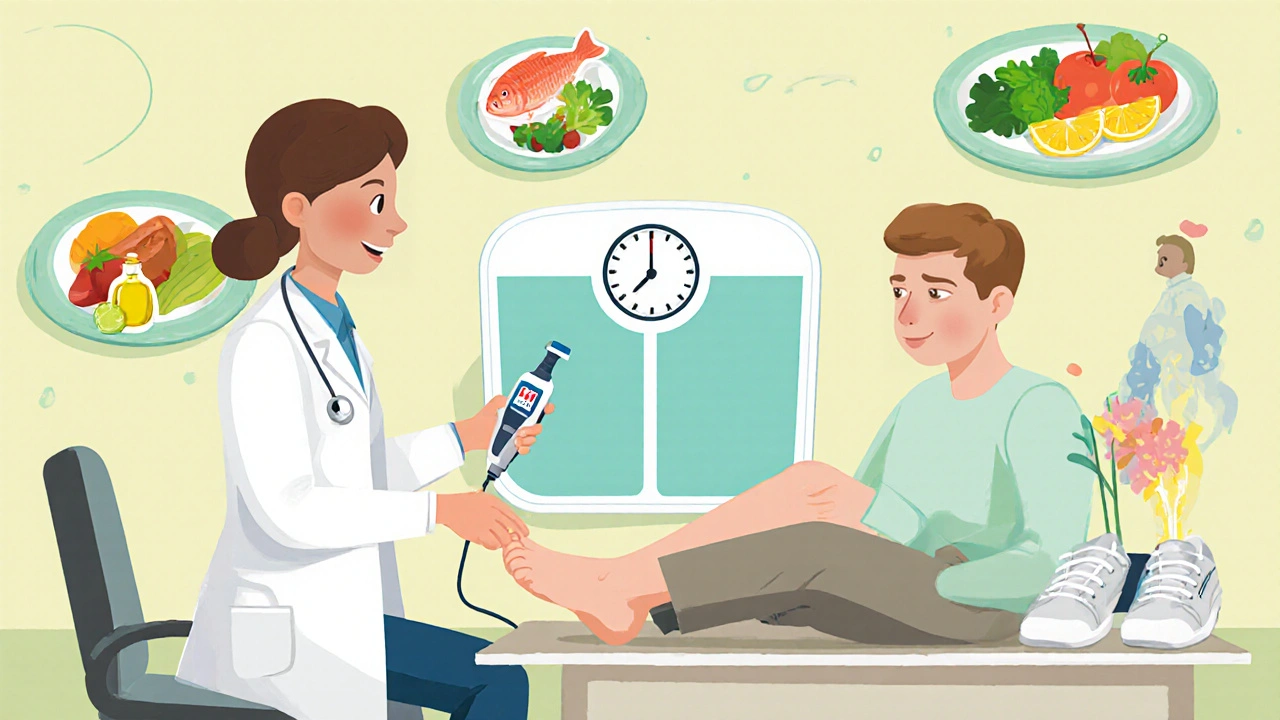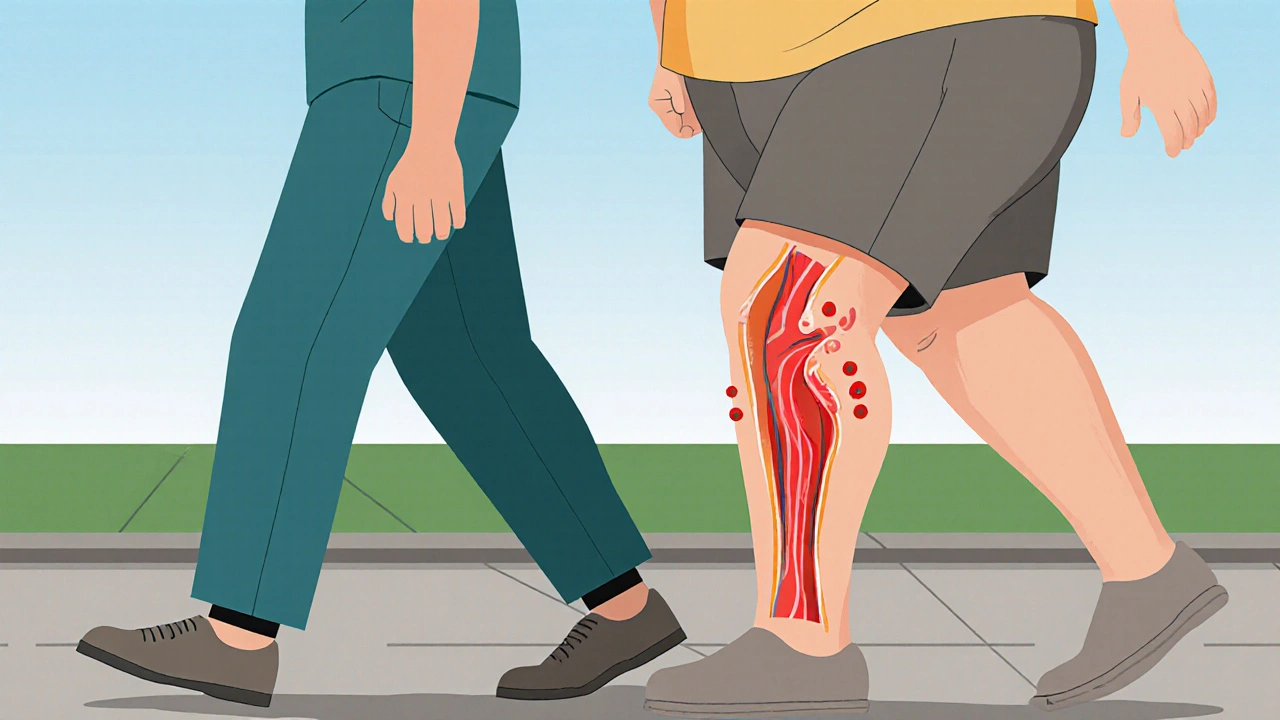Weight Loss Impact Calculator
How Weight Loss Improves Your Walking Distance
Based on research, losing 5-10% of your body weight can improve intermittent claudication symptoms by 30-50% in walking distance and increase ABI scores by 0.05-0.1.
Your Estimated Improvements
5% Weight Loss
(Approximate improvement)
10% Weight Loss
(Approximate improvement)
Real World Impact: A 10% weight loss could mean walking from 150m to 225m without pain - potentially avoiding surgery or improving daily activities.
If you’ve ever tried to walk a short distance and felt a painful cramp in your calf, you might be dealing with Intermittent Claudication, a hallmark symptom of peripheral artery disease (PAD). When excess body weight piles on, the problem can get a lot worse. In this article we’ll unpack why obesity fuels the pain, how doctors measure the risk, and-most importantly-what you can do right now to shed those extra pounds and walk pain‑free.
Key Takeaways
- Obesity accelerates atherosclerotic plaque buildup, narrowing leg arteries and triggering claudication sooner.
- Higher BMI correlates with lower ankle‑brachial index (ABI) scores and shorter painless walking distances.
- Even modest weight loss (5‑10% of body weight) can improve ABI by 0.05‑0.1 and extend walking time by 30‑50%.
- Combined approaches-diet, supervised walking, and medical therapy-work best.
- Seek a vascular specialist if pain appears after < 100 m of walking or if wounds on the feet fail to heal.
What Is Intermittent Claudication?
Intermittent claudication is muscle pain-most often in the calves, thighs, or buttocks-triggered by walking and relieved by rest. It’s caused by insufficient blood flow through the leg arteries, usually due to atherosclerosis, the buildup of fatty plaques inside the vessel walls. The condition belongs to the broader spectrum of Peripheral Artery Disease, which affects roughly 8 million adults in the United States and a rising number in Europe.
Why Obesity Makes Claudication Worse
When you add the Obesity label to the mix, several physiological changes line up to worsen PAD:
- Increased Inflammatory Load: Fat tissue releases cytokines such as IL‑6 and TNF‑α, which promote plaque instability and endothelial dysfunction.
- Higher Blood Viscosity: More circulating lipids thicken the blood, making it harder for the heart to push it through narrowed leg arteries.
- Elevated Blood Pressure: Extra weight forces the heart to work harder, raising systolic pressure and further straining arterial walls.
- Reduced Physical Activity: Overweight individuals often avoid walking, creating a vicious cycle of de‑conditioning and worsening claudication.
Studies from the Journal of Vascular Surgery (2023) show that patients with a body‑mass index (BMI) ≥ 30 kg/m² have a 1.8‑fold higher odds of reporting severe claudication compared to those with BMI < 25 kg/m².
How Doctors Measure the Problem
Two simple numbers tell most of the story:
- Body Mass Index (BMI): Weight (kg) ÷ height (m)². A BMI ≥ 30 kg/m² defines obesity; 25‑29.9 kg/m² is overweight.
- Ankle‑Brachial Index (ABI): Ratio of ankle systolic pressure to arm systolic pressure. Values <0.90 indicate PAD; the lower the number, the more severe the arterial narrowing.
Researchers often plot BMI against ABI to illustrate how weight gain compresses the ABI curve. In a 2022 UK cohort, each 5‑unit rise in BMI dropped the average ABI by 0.06.

Weight‑Loss Strategies That Actually Help Claudication
Not all diets are created equal for PAD patients. The goal is to lower inflammation, improve lipid profiles, and keep energy levels high for walking.
| Approach | Typical Weight Loss (6‑12 mo) | Impact on ABI | Effect on Walking Distance |
|---|---|---|---|
| Calorie‑Restricted Mediterranean Diet | 5‑10 % body weight | +0.05 - 0.10 | +30‑50 % |
| Low‑Carb/High‑Protein Plan | 8‑12 % body weight | +0.07 - 0.12 | +40‑60 % |
| Bariatric Surgery (gastric sleeve) | 25‑35 % body weight | +0.12 - 0.20 | +80‑120 % |
| Standard Care (no structured plan) | 0‑2 % body weight | ±0.00 | ±0 % |
Even a modest 5 % loss can shift an ABI from 0.78 to 0.83-enough to convert severe claudication into mild, allowing longer walks before pain starts.
Exercise Prescription: Walking Is Medicine
Walking isn’t just a diagnostic test; it’s a therapeutic tool. The classic “supervised walking program” follows a simple rule: walk until claudication pain appears, then rest until it fades, and repeat for 30‑45 minutes each session, three times a week.
- Start with a slow pace-aim for the point of mild discomfort, not severe cramping.
- Use a treadmill or flat outdoor surface; avoid hills until endurance improves.
- Track distance and pain onset in a journal to see progress.
When paired with weight loss, walking can boost functional capacity by up to 200 m in six months, according to a 2024 meta‑analysis of 14 trials.
Medical Adjuncts: When Lifestyle Needs a Boost
Doctors often add medications to address the underlying atherosclerosis:
- Statins: Lower LDL cholesterol and have modest anti‑inflammatory effects.
- Antiplatelet agents (e.g., aspirin): Reduce clot formation.
- ACE inhibitors: Control blood pressure, which indirectly eases arterial strain.
These drugs don’t replace weight loss but can accelerate improvements in ABI and walking distance when used together.
When to See a Vascular Specialist
If any of the following occur, schedule an appointment:
- Pain begins after walking less than 100 m.
- Foot ulcers develop or fail to heal within two weeks.
- Rest pain at night, especially when legs are raised.
- Sudden loss of pulse in the foot.
Early intervention can include angioplasty, stenting, or, in severe cases, bypass surgery-options that become more successful the lighter you are.
Putting It All Together: A 12‑Week Action Plan
- Week 1‑2: Record baseline weight, BMI, and walking distance. Start a Mediterranean‑style meal plan (≈500 kcal deficit).
- Week 3‑4: Begin supervised walking 3 × week, 30 minutes each. Add a daily 10‑minute stretch routine for calves.
- Week 5‑8: Increase walking duration by 5 minutes per session. Incorporate strength training (body‑weight squats, heel raises) twice a week.
- Week 9‑12: Re‑measure weight, BMI, and ABI (if you can). Adjust diet to maintain steady loss; consider a brief consult with a dietitian.
Stick to the plan, and you’ll likely see a noticeable dip in claudication pain, better walking stamina, and a healthier heart.
Bottom Line
Obesity isn’t just extra pounds-it's a heavy load on your leg arteries that speeds up claudication. Shedding even a modest amount of weight can lift the blockage, improve blood flow, and let you walk farther without pain. Combine a balanced diet, regular walking, and, when needed, medical therapy to give your legs the relief they deserve.

Sajeev Menon
October 22, 2025
Hey everybody, just wanted to point out that even a modest 5‑10% drop in weight can shift your ABI by a few tenths, which often translates to a noticeable boost in walking distance. It’s not just about dieting; incorporating gentle, low‑impact activities-like stationary cycling or water aerobics-helps improve circulation without over‑stressing the already narrowed vessels. Remember to keep a food diary; tracking calories and macronutrients makes the whole process more transparent and easier to stick to. And don’t forget to stay hydrated, because proper plasma volume supports blood flow. Lastly, if you’re unsure about the right target, chat with a vascular specialist who can tailor a plan to your specific BMI and ABI numbers. It’s crucial to conisder both diet and movement together.